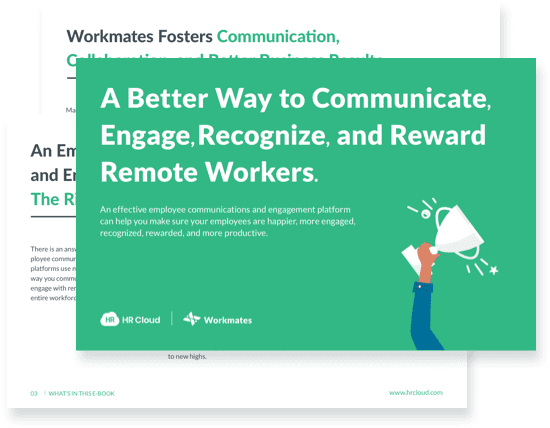- 1. Choose digital health solutions to keep remote employees healthy in the long term
- 2. Give remote employees resources to help make sure home workspaces are safe and comfortable
- 3. Address remote employee burnout, stress, and mental health.
- 4. Create a flexible reimbursement program for home exercise programs
- 5. Improve teamwork and reduce loneliness among remote employees
- Promote your wellness initiatives for remote workers year round
- Remote work is here to stay
HR leaders spent much of 2020 helping employees get used to new work from home arrangements and adapting benefits to be more remote-worker friendly.
Now, 2021 offers benefits leaders an opportunity to be more thoughtful about how to best support remote worker wellness next year, and beyond the pandemic.
From digital health solutions to social events designed to address worker loneliness, these five wellness initiatives address the specific needs of remote workers to improve health outcomes and boost employee engagement, too.

1. Choose digital health solutions to keep remote employees healthy in the long term
During the COVID-19 pandemic, digital health programs swooped in as a way to provide care for employees from home. As HR teams move benefits planning beyond crisis mode, there are a few steps you can take to determine which benefits are worth keeping around for the long haul.
Identify gaps between your in-person and remote resources. One simple place to start? Make sure there’s parity between your in-person and remote offerings. For example, if you have an on-site clinic, ensure your remote employees are aware of telehealth and other virtual care options available – and consider matching costs for both.
Provide mental health resources. Another large theme of COVID-19 has been mental health in the workplace. In a recent survey from McKinley, 62% of employees say that mental health has been a challenge for them during the pandemic. One third of large employers plan to expand mental health resources for employees next year, Business Group on Health found. Ninety-one percent plan to offer virtual care for mental health in 2021.
Address high-cost areas with virtual solutions. Planning ahead for next year and beyond the pandemic also gives employers the opportunity to evaluate how virtual care can address long-standing healthcare costs. Musculoskeletal pain, for example, is a top cost for 90% of large employers, according to Business Group on Health. Virtual solutions can help people in pain avoid expensive surgery by accessing appropriate exercise therapy and education from home. In the BGH survey, 68% of employers said they plan to launch a digital musculoskeletal employer program by 2023.
2. Give remote employees resources to help make sure home workspaces are safe and comfortable
Workplace safety isn’t just for factory floors and in-person offices. While the risk of injury is typically lower in home offices, it’s still important to offer employees guidance and resources to help make their spaces as comfortable as possible. Comfort pays off: Studies show that addressing health issues related to poor ergonomics like eye strain and back pain boost productivity.
Provide remote employees with a budget to upgrade their home offices, whether that includes a new chair, standing desk, better lighting, or other adjustments. Don’t send them shopping without sharing recommendations first, though – best practices can differ based on needs. For example, an employee may want to place their computer screen at a different angle based on whether they’re dealing with dry eye or back pain.
Back and neck pain tips for remote workers:
-
Check your posture. Align your elbows at a 90-degree angle, with your feet flat on the floor.
-
Use a pillow or cushion, or ergonomic chair, for low back support.
-
Switch up your position throughout the day. Try standing at a kitchen counter or dresser for a makeshift standing desk.
Eye health tips for remote workers:
-
Sit near a window. Employees seated within 10 feet of a window reported an 84% decrease in eyestrain, headaches, and blurred vision, according to a study conducted by the Department of Design and Environmental Analysis at Cornell.
-
Adjust your computer screen to be 15 to 20 degrees below eye level to reduce eye dryness and strain.
-
Follow the 20-20-20 rule. Try this approach to reduce eye strain: Every 20 minutes, look away from your screen towards an object 20 feet away, for twenty seconds.
Chief Executive Officer of Medlinks Cost Containment, Inc. and Medlinks Staffing, LLC.
“Our staff has praised the increased communications level Workmates delivers. We use it to communicate important project matters and give staff specific ‘kudos’ or even recognize their birthdays. More importantly, we use Workmates to clarify important project details that needed rapid dissemination among the entire team.”
3. Address remote employee burnout, stress, and mental health.
Stress and work-life balance are also part of employee wellness. Remote employees in particular are prone to working long hours and struggling to detach from the workday. In fact, 69 percent of people working from home during COVID-19 are experiencing burnout, according to a survey from Monster. Top causes of burnout include overwhelming workloads, lack of work-life balance, and confusion around expectations.
Employee burnout can have serious health consequences, from insomnia and stomach issues, to an increased risk of cardiovascular disease. Signs include irritability and decreases in work quality – alerts that can be easy to miss if you’re managing remote employees.
To help, train both employees and managers on the signs of burnout. Give direct reports their own training so they can recognize signs in themselves – and encourage them to speak up when they feel overwhelmed.
Regularly showing gratitude to employees, discouraging them from responding to messages after hours, and encouraging vacation time can all help, too. Companies simply must do all they can communicate, collaborate, and engage with remote teams, and this need will only be increased in 2021.
4. Create a flexible reimbursement program for home exercise programs
If you already provide a gym membership reimbursement to your employees, encourage employees to use the same allotment for online exercise programs. You can also provide employees with a stipend to purchase exercise equipment for home, such as dumbbells, yoga mats, and resistance bands.
Another perk of working from home? It can be easier to fit movement into your day. Consider encouraging employees to take an exercise break in the morning or afternoon. Exercise is proven to boost thinking and memory skills. Research also shows that exercising during the workday improves employee engagement and satisfaction.
5. Improve teamwork and reduce loneliness among remote employees
Loneliness and lack of connectivity to peers is the top concern of remote employees. Overall in the U.S., loneliness has been considered an “epidemic” on its own. Loneliness in younger people is associated with a higher risk of depression and anxiety.
Loneliness is an employee engagement issue, too – on average, lonely workers say that they think about quitting their job more than twice as often as non-lonely workers, according to a study conducted by Cigna.
While loneliness can be unrelated to remote work, or just a piece of it, employers can still help create a more connected and engaged workplace. (if you’re interested in more information, download our eBook, “A Better Way to Communicate and Engage with Remote Workers” today.)
Send a company newsletter that shares work and personal updates. Encourage employees to share pictures of their kids, pets, and hobbies as a way to help team members get to know each other, even if they haven’t met in person.
Encourage one-on-one coffee meetings. Apps and messaging tools pair coworkers up randomly for a 30-minute chat. Meetings are optional and no pressure, but can help employees recreate the “water cooler” effect remotely.
Empower employees to recognize and reward their peers. For example, HR Cloud’s Workmates solution includes powerful recognition and rewards capabilities. With Workmates, any employee can offer a “kudos” to recognize a peer’s accomplishment or just the hard work they do every day. Kudos points can even be linked to rewards such as gift cards, corporate items, or other ideas. Engagement, collaboration, and productivity will soar.

To learn even more about managing remote teams and keeping employees working at home highly engaged, download our ebook now.
Download nowPut extra effort into engaging new employees. Team members who joined your company in 2020 may have never met their new colleagues in person. Even under normal circumstances, there’s a learning curve when it comes to feeling connected – 67% of employees who have been at a company for less than six months report that they feel alone at least some of the time. Schedule one-on-one meetings for new employees both with their manager and across teams to help.
Help employees feel connected to something larger. Working remotely can make employees feel like they’re in a vacuum. Regularly highlight how each team’s work ladders up to your company goals. When it’s safe to do so, consider organizing a group volunteering project, or for more far-flung remote teams, offer a day off per year for volunteering.
Promote your wellness initiatives for remote workers year round
Before employees are able to engage with and benefit from your new wellness strategy, they first have to hear about it.
Employee benefits communications look different for remote employees – for better and for worse. While emails may be easier to send, they’re not necessarily more engaging than an in-person benefits fair.
Take a page from a digital marketer’s playbook and share your benefits messages in multiple places:
-
Send a series of emails over the course of a few weeks
-
Make an announcement on Slack, then “pin” the message for easy access later
-
Announce your new benefits programs during an all-staff meeting.
-
Encourage HR managers to include a link to the company intranet in their email signatures.
Remote work is here to stay
Remote work is popular. In Buffer’s State of Remote Work for 2020, 98% of respondents said they would like to work remotely for the rest of their career. The survey was conducted in 2019, so we haven’t seen the results of our great remote work experiment pan out in surveys yet, but positive reporting around remote work has been consistent every year the survey has been conducted.
Though remote work brings its own challenges, overall, remote workers are often more productive and better engaged. And the more connected and supported remote employees feel thanks to wellness initiatives designed with them in mind, the better.
About the author: Nancy Ryerson is a healthcare writer with a passion for employee benefits and engagement. She is Senior Marketing Manager at Fern Health, a digital health company that provides virtual musculoskeletal pain programs through employers. Prior to Fern, she covered patient centricity in clinical trials at Antidote and the patient experience at The Michael J. Fox Foundation.

Keep Reading
Balancing Technology and the Human Touch in Employee Engagement
Companies are taking employee engagement very seriously because it is one of the ways of
Building Strong Teams: The Power of Team Bonding Exercises
Never overestimate the power of collaboration as a core element of effective team



